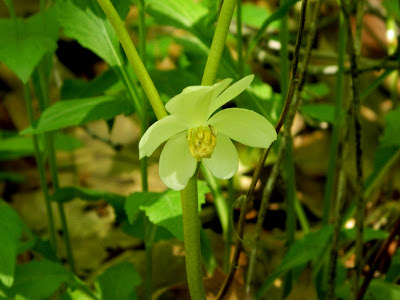Secret of surviving long-distance road-tripping: Always have the necessities close at hand, like your cell phone, chapstick, energy drink, beads from the previous weekends' Ke$ha-themed party, gas receipt to remind you that you're back in the real world, and tissues because you've been balling your eyes out for the past twenty miles.
I was a Drifter then, and I'm a Drifter still, and we all knew I would come back to these bluffs. For the next six months, I'll be working at Effigy Mounds National Monument, and have once again have taken up residence in my cousin's basement.
While I am glad to be back, and have for the most part fallen into old patterns and routines, I'm still in the transition period. It's almost as though we all must reintroduce ourselves to one another.
 |
| You didn't think I was talking about people, did you? |
 |
| Wild Geranium |
 |
| Virginia Waterleaf |
 |
| Red Columbine |
 |
| Wild Blue Phlox or Wild Sweet William |
 |
| May Apple |
 |
| Blue-eyed grass, one of my favorites! Often mistaken for grass, it's a member of the Iris family. |
 |
| Rue Anemone peeking out from the shade |
Perhaps I'm being misleading. There are not fields of colorful blossoms waiting to greet visitors. When you walk along the trails, this is what you're really seeing:
 |
| A sea of green. But those are May Apples in the lower right-hand corner, and there are clumps of Blue-eyed grass along the trails that small dogs might be eye-level with. |
Not all spring woodland wildflowers are dainty and pretty. Others are straight-up weird.
 |
| Like the Jack-in-the-Pulpit, which seem to grow to a monstrous size at Effigy Mounds. |
 |
| Weirdo #2: Pussytoes, with its dense white flowers. This is going to seed on one side. |
All of the wildflowers were growing along the trail up to Fire Point, the most popular lookout point in the monument. It doesn't take a naturalist to figure out why people find it breathtaking.
 |
| Fire Point, May 10 |
Wildflowers and vistas aren't the only curiousities out and about. The Eastern Tent Caterpillars have found their way to this area, and they can be found crawling on every surface, whether it be the ironwood railings, the building, or various people.
The caterpillars have an interesting life cycle. Everything starts out as a black and slimy egg mass, which then hatches into dozens of caterpillars who then communally spin a "tent" for themselves in the branches. They will come out of their little abode to feed on yummy leaves, and then will return home to snuggle up with their brothers and sisters. Yup, social caterpillars. They can easily defoliate an entire tree, and maybe some of its neighbors, too, but the whole event occurs so early in the year that the trees usually grow new leaves by mid-summer. The tent caterpillars then transform into ordinary brown moths, and since moths aren't known for staying the same place, they will flitter about on the wind and be carried to a new patch of forest to lay their eggs. So the big increases in population, "invasions" if you will, are a naturally occurring phenomenon.
I also have big, important news! Remember in this post I let loose the secret I had never actually seen a Cerulean Warbler, the bird I would go on and on about whenever the word "conservation" was brought up?
As of May 10, 2012, I can say this with full confidence: They do exist. And they are just as awesome as I had imagined them.
Sorry, no photo was possible as the long-awaited viewing was through binoculars and the tiny bird liked to hope around the tree branches and hide behind leaves.





3 comments:
Glad to have you back! The Ceruleans are singing away - Jessica @ EFMO
I am always amazed at your ecological knowledge - I would call those flowers "blue, red, white, and yellow." :) What a beautiful place to spend the summer - I hope it gives you lots of time to reflect and bask in the natural world that you love so much. Miss you!
Jayme
Thanks, Jessica! It's good to be back in bluff country!
And Jayme, don't be too impressed, I had to look up half of those flowers! Miss you, too!
Post a Comment